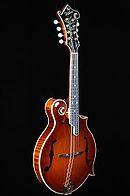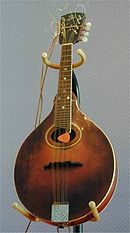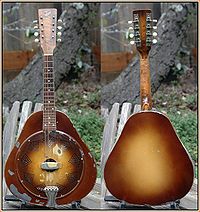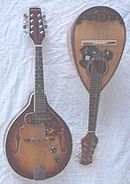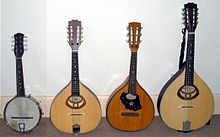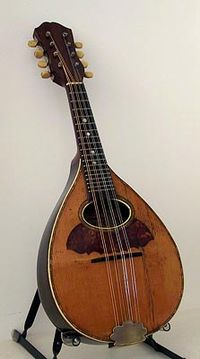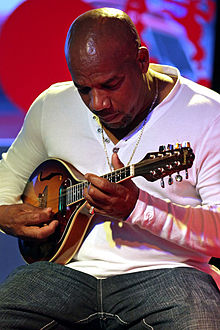- Mandolin
-
This article is about the musical instrument. For the cooking tool, see Mandoline.
Mandolin 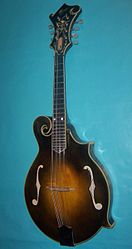
A Glenn F5 Fern mandolinString instrument Classification Plucked string instrument Hornbostel–Sachs classification 321.321-6
(Composite chordophone sounded by a plectrum)Developed Mid 18th century from the mandolino Playing range (a regularly tuned mandolin with 14 frets to body)Related instruments - Family
- Mandolin
- Mandola
- Octave mandolin
- Mandocello
- Mandobass
- Angélique (instrument)
- Archlute
- Balalaika
- Barbat (lute)
- Bağlama
- Baglamas
- Biwa
- Bouzouki
- Charango
- Chitarra Italiana
- Daguangxian
- Đàn tỳ bà
- Dombra
- Domra
- Dutar
- Electric pipa
- Erhu
- Irish bouzouki
- Kobza
- Liuqin
- Lute
- Mandriola
- Oud
- Pandura
- Pipa
- Rubab
- Setar
- Sitar
- Surbahar
- Tambouras
- Tanbur
- Tanbur (Turkish)
- Tembûr
- Theorbo
- Tiorbino
- Tiqin
- Topshur
- Tricordia
- Ukulele
- Veena
- Zhonghu
A mandolin (Italian: mandolino) is a musical instrument in the lute family (plucked, or strummed). It descends from the mandore, a soprano member of the lute family. The mandolin soundboard (the top) comes in many shapes—but generally round or teardrop-shaped, sometimes with scrolls or other projections. A mandolin may have f-holes, or a single round or oval sound hole. A round or oval sound hole may be bordered with decorative rosettes or purfling, but usually does not feature an intricately carved grille like a Baroque era mandolin.[1][2]
Early mandolins had six double courses of gut strings, tuned similarly to lutes, and plucked with the fingertips. Modern mandolins—which originated in Naples, Italy in the late 18th century—commonly have four double courses (four pairs) of metal strings, which are plucked with a plectrum.
Many variants of the mandolin have existed. These include Milanese, Lombard, Brescian and other six-course types, as well as four-string (one string per course), twelve-string (three strings per course), and sixteen-string (four strings per course).
Contents
Construction
A mandolin typically has a hollow wooden body with a tailpiece that holds one end of the strings, a floating bridge, a neck with a flat (or slight radius) fretted fingerboard, a nut, and mechanical tuning machines to accommodate metal strings.
Like any plucked instrument, mandolin notes decay to silence rather than sound out continuously as with a bowed note on a violin. Its small size and higher pitch make mandolin notes decay faster than larger stringed instruments like guitar, which encourages the use of tremolo (rapid picking of one or more pairs of strings) to create sustained notes or chords. The mandolin's paired strings facilitate this technique: the plectrum (pick) strikes each of a pair of strings alternately, providing a more full and continuous sound than a single string would.
Various design variations and amplification techniques have been used to make mandolins compatible in volume with louder instruments and orchestras. Hybridization with the louder banjo creates the mandolin-banjo, and resonators have been used, most notably by Dobro and the National String Instrument Corporation. Some musicians play electric mandolins through amplifiers.
Variations
Bowlback
Mandolins come in several forms. The Neapolitan style, known as a round-back or bowl-back (or "tater-bug," colloquial American) has a vaulted back made of a number of strips of wood in a bowl formation, similar to a lute, and usually a canted, two-plane, uncarved top. Another form has a banjo-style body.
Archtop
At the very end of the nineteenth century, a new style, with a carved top and back construction inspired by violin family instruments began to supplant the European-style bowl-back instruments, especially in the United States. This new style is credited to mandolins designed and built by Orville Gibson, a Kalamazoo, Michigan luthier who founded the "Gibson Mandolin-Guitar Manufacturing Co., Limited" in 1902. Gibson mandolins evolved into two basic styles: the Florentine or F-style, which has a decorative scroll near the neck, two points on the lower body, and usually a scroll carved into the headstock; and the A-style, which is pear shaped, has no points, and usually has a simpler headstock.
These styles generally have either two f-shaped soundholes like a violin (F-5 and A-5), or an oval sound hole (F-4 and A-4 and lower models) directly under the strings. Much variation exists between makers working from these archetypes, and other variants have become increasingly common. Generally, Gibson F-hole F-5 mandolins and mandolins influenced by that design are strongly associated with American bluegrass music, while the A-style is more associated with Irish, folk, or classical music. The F-5s more complicated woodwork also translates into a more expensive instrument.
Internal bracing to support the top in the F-style mandolins is usually achieved with parallel tone bars, similar to the bass bar on a violin. Some makers instead employ "x-bracing," which is two tone bars mortised together to form an X. Some luthiers now using a "modified x-bracing" that incorporates both a tone bar and x-bracing.
Numerous modern mandolin makers build instruments that largely replicate the Gibson F-5 Artist models built in the early 1920s under the supervision of Gibson acoustician Lloyd Loar. Original Loar-signed instruments are sought after and extremely valuable. Other makers from the Loar period and earlier include Lyon and Healy, Vega, and Larson Brothers. Notable modern American mandolin manufacturers include Weber, Monteleone, and Collings. Mandolins from other countries include The Loar (China), Michael Kelly (Korea), Eastman (China), Kentucky(China), and Morgan Monroe(China).
Others
Other American-made variants include the mandolinetto or Howe-Orme guitar-shaped mandolin (manufactured by the Elias Howe Company between 1897 and roughly 1920), which featured a cylindrical bulge along the top from fingerboard end to tailpiece; the Army-Navy style with a flat back and top; and the Vega mando-lute (more commonly called a cylinder-back mandolin manufactured by the Vega Company between 1913 and roughly 1927), which had a similar longitudinal bulge but on the back rather than the front of the instrument.
As with almost every other contemporary string instrument, another modern variant is the electric mandolin. These mandolins can have four or five individual or double courses of strings.
History
Mandolins evolved from the lute family in Italy during the seventeenth and eighteenth centuries, and the deep bowled mandolin, produced particularly in Naples, became common in the nineteenth century. The original instrument was the mandore, which evolved in the fourteenth century from the lute. Over time and as the instrument spread around Europe, it took on many names and various structural characteristics.
Further back, dating to around 15,000 BC to 8000 BC, single-stringed instruments have been seen in cave paintings and murals. They were struck, plucked, and eventually bowed. From these, the families of stringed instruments developed. Single strings were long and gave a single melody line. To shorten the scale length, other strings were added with a different tension and pitch so one string took over where another left off. In turn, this led to being able to play dyads and chords. The bowed family became the rabob, and then the rebec fiddle, evolving into the modern violin family by 1520 (incidentally also in Italy). The plucked family led to lute-like instruments in 2000 BC Mesopotamia, and developed into the oud or ud before appearing in Spain, first documented around 711 AD, courtesy of the Moors.
Over subsequent centuries, the strings were doubled to courses, and eventually (in Europe) frets were added, leading to the first lute appearing in the thirteenth century. The history of the lute and the mandolin are intertwined from this point. The lute gained a fifth course by the fifteenth century, a sixth a century later, and up to thirteen courses in its heyday. As early as the fourteenth century a miniature lute or mandora appeared. Like the mandola, it had counterparts in Assyria (pandura), the Arab countries (dambura), and Ukraine (kobza-bandura). From this, the mandolino (a small cat gut-strung mandola with six strings tuned g b e' a' d g sometimes called the Baroque mandolin or cat-banjo and played with a quill, wooden plectrum or finger-style) was developed in several places in Italy. A nearly identical instrument called the mandore was used in France at the same time. The mandolino was sometimes called a mandolin in the early eighteenth century (around 1735) Naples. At this point, all such instruments were strung with gut strings.
The first evidence of modern steel-strung mandolins is from literature regarding popular Italian players who traveled through Europe teaching and giving concerts. Notable are Signor Leone and G. B. Gervasio, who traveled widely between 1750 and 1810.[2] This, with the records gleaned from the Italian Vinaccia family of luthiers in Naples, Italy, led some musicologists to believe that the modern steel-strung mandolin was developed in Naples by the Vinaccia family. Gennaro Vinaccia was active c. 1710 to c. 1788, and Antonio Vinaccia was active c. 1734 to c. 1796.[3] An early extant example of a mandolin is one built by Antonio Vinaccia in 1772, which resides at the Victoria and Albert Museum in London, England. Another is by Giuseppe Vinaccia, built in 1763, residing at the Kenneth G. Fiske Museum of Musical Instruments in Claremont, California.[4] The earliest extant mandolin was built in 1744 by Gaetano Vinaccia. It resides in the Conservatoire Royal de Musique in Brussels, Belgium.[5]
These mandolins, like their modern descendants, are called Neapolitan mandolins because they originate in Naples, Italy. They are distinguished by an almond-shaped body with a bowled back constructed from curved strips of wood along its length. The sound table is bent just behind the bridge, the bending achieved with a heated bending iron. This "canted" table helps the body support a greater string tension. A hardwood fingerboard is flush with the soundtable. Ten metal or ivory frets are spaced along the neck in half-steps, with additional frets glued upon the soundtable. The strings are brass except for the lowest string course, which are gut or metal wound onto gut. The bridge is a movable length of hardwood or ivory placed in front of ivory pins that hold the strings. Wooden tuning pegs are inserted through the back of a flat pegboard. The mandolins have a tortoise shell pickguard below the soundhole under the strings. A quill or shaped piece of tortoise shell is used as a plectrum.[5][6]
Other luthiers who built mandolins included Rafaele Calace (1863 onwards) in Naples, Luigi Embergher (1856–1943) in Rome, the Ferrari family (1716 onwards, also originally mandolino makers) in Rome, and De Santi (1834–1916) in Rome. The Neapolitan style of mandolin construction was adopted and developed by others, notably in Rome, giving two distinct but similar types of mandolin – Neapolitan and Roman.
The twentieth century saw the rise in popularity of the mandolin for Celtic, bluegrass, jazz, and classical styles. Much of the development of the mandolin from Neapolitan bowl-back to the flat-back style (actually, gently rounded and carved like a violin) is attributable to Orville Gibson (1856–1918). See above.
Tuning
A variety of different tunings are used. Usually, courses of 2 adjacent strings are doubled (tuned to the same pitch). The most common tuning by far, GDAE, is the same as violin tuning:
- fourth (lowest tone) course: G3 (196.00 Hz)
- third course: D4 (293.66 Hz)
- second course: A4 (440.00 Hz; A above middle C)
- first (highest tone) course: E5 (659.25 Hz)

Other tunings exist, including "cross-tunings," in which the usually doubled string runs are tuned to different pitches. Additionally, guitarists may sometimes tune a mandolin to mimic a portion of the intervals on a standard guitar tuning to achieve familiar fretting patterns.
Mandolin family
The mandolin is the soprano member of the mandolin family, as the violin is the soprano member of the violin family. Like the violin, its scale length is typically about 13 inches (330 mm). Modern American mandolins modeled after Gibsons have a longer scale, about 13-7/8" (352 mm).
Other members of the mandolin family are:
- The mandola (US and Canada), termed the tenor mandola in Britain and Ireland and liola or alto mandolin in continental Europe, which is tuned to a fifth below the mandolin, in the same relationship as that of the viola to the violin. Some also call this instrument the "alto mandola." Its scale length is typically about 16.5 inches (420 mm). It is normally tuned like a viola: C-G-D-A.
- The octave mandolin (US and Canada), termed the octave mandola in Britain and Ireland and mandola in continental Europe, which is tuned an octave below the mandolin. Its scale length is typically about 20 inches (500 mm), although instruments with scales as short as 17 inches (430 mm) or as long as 21 inches (530 mm) are not unknown.
- The mandocello, which is classically tuned to an octave plus a fifth below the mandolin, in the same relationship as that of the cello to the violin: C-G-D-A. Today, it is frequently restrung for octave mandolin tuning or the Irish bouzouki's GDAD. Its scale length is typically about 25 inches (635 mm). A typical violoncello scale is 27" (686 mm).
- The Greek laouto is essentially a mandocello, ordinarily tuned D-G-D-A, with half of each pair of the lower two courses being tuned an octave high on a lighter gauge string. The body is a staved bowl, the saddle-less bridge glued to the flat face like most ouds and lutes, with mechanical tuners, steel strings, and tied gut frets. Modern laoutos, as played on Crete, have the entire lower course tuned in octaves as well as being tuned a reentrant octave above the expected D. Its scale length is typically about 28 inches (712 mm).
- The mando-bass, has 4 single strings, rather than double courses, and is tuned like a double bass or an acoustic bass guitar. These were made by the Gibson company in the early twentieth century, but appear to have never been very common. Reportedly, most mandolin orchestras preferred to use the ordinary double bass, rather than a specialised mandolin family instrument. Calace and other Italian makers predating Gibson also made mandolin-basses.
- The piccolo or sopranino mandolin is a rare member of the family, tuned one octave above the tenor mandola and one fourth above the mandolin; the same relation as that of the piccolo or sopranino violin to the violin and viola. One model was manufactured by the Lyon & Healy company under the Leland brand. A handful of contemporary luthiers build piccolo mandolins. Its scale length is typically about 9.5 inches (240 mm).
- The Irish bouzouki is also considered a member of the mandolin family; although derived from the Greek bouzouki, it is constructed like a flat backed mandolin and uses fifth-based tunings, most often GDAE (an octave below the mandolin), although sometimes GDAD, ADAD or ADAE are used in place of the guitar-like fourths-and-third tunings of the three- and four-course Greek bouzouki. Although the bouzouki's bass course pairs are most often tuned in unison, on some instruments one of each pair is replaced with a lighter string and tuned in octaves, in the fashion of the 12-string guitar. Although occupying the same range as the octave mandolin/octave mandola, the Irish bouzouki is distinguished from the former instrument by its longer scale length, typically from 22 inches (560 mm) to 24 inches (610 mm), although scales as long as 26 inches (660 mm), which is the usual Greek bouzouki scale, are not unknown.
- The modern cittern is also an extension of the mandolin family, being typically a five course (ten string) instrument having a scale length between 20 inches (500 mm) and 22 inches (560 mm). It is most often tuned to either DGDAD or GDADA, and is essentially an octave mandola with a fifth course at either the top or the bottom of its range. Some luthiers, such as Stefan Sobell also refer to the octave mandola or a shorter-scaled Irish bouzouki as a cittern, irrespective of whether it has four or five courses.
- In Indian classical music and Indian light music, the mandolin, which bears little resemblance to the European mandolin, is likely to be tuned to E-B-E-B. As there is no concept of absolute pitch in Indian classical music, any convenient tuning maintaining these relative pitch intervals between the strings can be used. Another prevalent tuning with these intervals is C-G-C-G, which corresponds to Sa-Pa-Sa-Pa in the Indian carnatic classical music style. This tuning corresponds to the way violins are tuned for carnatic classical music.
Mandolin music
Mandolins have a long history, and much early music was written for them. In the first half of the 20th century, they enjoyed a period of great popularity in Europe and the Americas as an easier approach to playing string music. Many professional and amateur mandolin groups and orchestras were formed to play light classical string repertory. Just as this practice was falling into disuse, the mandolin found a new niche in American country, old-time music, bluegrass, and folk music. More recently, the Baroque and Classical mandolin repertory and styles have benefited from the raised awareness of and interest in Early music. Tremolo and fingerpicking methods are used while playing a mandolin.
Australia
The earliest references to the mandolin in Australia come from Phil Skinner MBE (1903–1991). In his article "Recollections"[7] he mentions a Walter Stent, who was “active in the early part of the century and organised possibly the first Mandolin Orchestra in Sydney.” He also refers to Roy Smedley, a student of Walter Stent, who performed on the radio and “was a most outstanding mandolinist, prominent over many years; his technique, choice of solos and stage presentation left little to be desired, and the students he produced did him great honour”.[citation needed]
Phil Skinner played a key role in the development of the mandolin movement in Australia in the 20th century and was awarded an MBE in 1979 for services to music and the community. He was born Harry Skinner in Sydney in 1903 and started learning music at age 10 when his uncle (who couldn’t read music) tutored him on the banjo. Phil began teaching part time at age 18 years until the Depression Years forced him to begin teaching full time and learn a broader range of instruments. Phil founded the Sydney Mandolin Orchestra, the oldest surviving mandolin orchestra in Australia.[citation needed]
On 30 January 1976, Harry Baker of the Fremantle Music School in Western Australia organised a meeting to consider forming a mandolin orchestra in Fremantle. Seventeen interested people attended and decide to proceed. News of this is published in the Independent Post on 4 February 1976 along with an appeal for more players. Robert Schulz, a music teacher, is appointed conductor. The Fremantle-Coburn News announced that the Fremantle Music School had put together a mandolin group consisting of 8 players (2 of each: 1st & 2nd mandolin, mandola, guitar), but looking for 30-40 others. Initially called the Fremantle Mandolin Orchestra, it later became the West Australian Mandolin Orchestra(WAMO), which survives today (2009) with approx 30 players.[citation needed]
By 1974, a mandolin ensemble called Varianten has formed in Geelong, Victoria and eventually becomes the Geelong Mandolin Orchestra (GMO).
The Sydney Mandolins (Artistic Director Adrian Hooper) has made a major contribution to mandolin music in Australia and a significant amount of mandolin music was composed for this ensemble, and their lasting legacy is their extensive recordings of these works (over 115 CDs), which are still heard on ABC Classic FM radio today.[citation needed] Composers they have commissioned include Dr Eric Gross, Ann Carr-Boyd, Larry Sitsky, Caroline Szeto, Betty Beath, Ian Shanahan and John Peterson. Their virtuoso mandolinist Paul Hooper has had many solo works written for him as well as number of Mandolin Concertos which he has performed with the Tasmanian Symphony Orchestra and Sydney Symphony Orchestra.
In January 1979, the Federation of Australian Mandolin Ensembles (FAME) Inc. was formed. Bruce Morey from Melbourne is the first FAME President. Plans were made to send an Australian Mandolin Orchestra on a tour to Germany, which occurred May 1980.
In Australian country and folk, the mandolin is not unknown. Groups such as My Friend The Chocolate Cake use the mandolin extensively. The McClymonts also use the mandolin, as do Mic Conway's National Junk Band and the Blue Tongue Lizards. Nevertheless, in folk and traditional styles, the mandolin remains more popular in Irish Music and other traditional repertoires.
Brazil
The mandolin has a long and rich tradition in Brazilian folk music, especially in the style called choro. The composer and mandolin virtuoso Jacob do Bandolim did much to popularize the instrument through many recordings, and his influence continues to the present day. Some contemporary mandolin players in Brazil include Jacob's disciple Deo Rian, and Hamilton de Holanda (the former, a traditional choro-style player, the latter an eclectic innovator).
The mandolin came into Brazil by way of Portugal. Portuguese music has a long tradition of mandolins and mandolin-like instruments (see, for example, the Portuguese guitar).
The mandolin is used almost exclusively as a melody instrument in Brazilian folk music - the role of chordal accompaniment being taken over by the cavaco and nylon-strung guitar. Its popularity, therefore, has risen and fallen with instrumental folk music styles, especially choro. The later part of the 20th century saw a renaissance of choro in Brazil, and with it, a revival of the country's mandolinistic tradition.
Continental Europe
See also: Czech bluegrassAn increased interest in bluegrass music, especially in Central European countries such as the Czech Republic and Slovak Republic, has inspired many new mandolin players and builders. These players often mix traditional folk elements with bluegrass. Classically, Beethoven composed mandolin music[8] and enjoyed playing the mandolin.[9] The opera Don Giovanni by Mozart includes some mandolin parts. Also very well known are the mandolin concerti by Vivaldi. Some 20th century classical composers also used the mandolin as their instrument of choice (amongst these are: Schoenberg, Webern, Stravinsky, Zappa).
Greece
The mandolin has a long tradition in the Ionian islands (the Heptanese) and Crete. It has long been played in the Aegean islands outside of the control of the Ottoman Empire. It is common to see choirs accompanied by mandolin players (the mandolinátes) in the Ionian islands and especially in the cities of Corfu, Zakynthos, and Kefalonia. The evolution of the repertoire for choir and mandolins (kantádes) occurred during Venetian rule over the islands.
On the island of Crete, along with the lyra and the laouto (lute), the mandolin is one of the main instruments used in Cretan Music. It appeared on Crete around the time of the Venetian rule of the island. Different variants of the mandolin, such as the "mantola," were used to accompany the lyra, the violin, and the laouto. Stelios Foustalierakis reported that the mandolin and the mpougari were used to accompany the lyra in the beginning of the 20th century in the city of Rethimno. There are also reports that the mandolin was mostly a woman's musical instrument. Nowadays it is played mainly as a solo instrument in personal and family events on the Ionian islands and Crete.
India
Mandolin music was used in the Indian Movies as far back as the 1940s by the Raj Kapoor Studios in movies such as Barsaat, Awara etc. Adoption of the mandolin in Carnatic music is recent and, being essentially a very small electric guitar, the instrument itself bears rather small resemblance to European and American mandolins. U. Srinivas has, over the last couple of decades, made his version of the mandolin very popular in India and abroad. Many adaptations of the instrument have been done to cater to the special needs of Indian Carnatic music.
This type of mandolin is also used in Bhangra, dance music popular in Punjabi culture.
Ireland
The mandolin is becoming a somewhat more common instrument amongst Irish traditional musicians. Fiddle tunes are readily accessible to the mandolin player because of the equivalent range of the two instruments and the practically identical (allowing for the lack of frets on the fiddle) left hand fingerings.
Although almost any variety of acoustic mandolin might be adequate for Irish traditional music, virtually all Irish players prefer flat-backed instruments with oval sound holes to the Italian-style bowl-back mandolins or the carved-top mandolins with f-holes favoured by bluegrass mandolinists. The former are often too soft-toned to hold their own in a session (as well as having a tendency to not stay in place on the player's lap), whilst the latter tend to sound harsh and overbearing to the traditional ear. The f-hole mandolin, however, does come into its own in a traditional session, where its brighter tone cuts through the sonic clutter of a pub. Greatly preferred for formal performance and recording are flat-topped "Irish-style" mandolins (reminiscent of the WWI-era Martin Army-Navy mandolin) and carved (arch) top mandolins with oval soundholes, such as the Gibson A-style of the 1920s. Noteworthy Irish mandolinists include Andy Irvine (who almost always tunes the E down to D), Mick Moloney, Paul Kelly, and Claudine Langille. John Sheahan and Barney McKenna, fiddle player and tenor banjo player respectively, with The Dubliners are also accomplished Irish mandolin players. The Dubliners "Live at the Gaiety" DVD features an extensive mandolin duet of a three-tune "set," two hornpipes and a reel. The instruments used are flat-backed, oval hole examples as described above: in this case made by UK luthier Roger Bucknell of Fylde Guitars. The Irish guitarist Rory Gallagher often played the mandolin on stage, and he most famously used it in the song "Going To My Hometown."
Japan
Instruments of the mandolin family are popular in Japan, particularly Neapolitan (round-back) style instruments. Morishige Takei (1890–1949), who studied Italian in Tokyo College of Language and was a member of the court of Emperor Hirohito, established the mandolin orchestra in the Italian style before World War II. The military government could not persecute Japanese mandolinists by the authority of Takei[citation needed] and Italy as the Axis. So the Japanese mandolin orchestras continued to perform old Italian works after World War II, and they are prosperous today. In addition, Jiro Nakano (1902–2000) arranged many of the Italian works for regular orchestras or winds composed before World War II as new repertoires for Japanese mandolin orchestras.
Original compositions for mandolin orchestras were more and more composed after World War II. Seiichi Suzuki (1901–1980) and Tadashi Hattori (1908–2008) composed music for early Kurosawa films and many symphonic works for mandolin orchestras. Hiroshi Ohguri (1918–1982) was influenced by Béla Bartók. Yasuo Kuwahara (1946–2003) used German techniques.
Japanese mandolin orchestras consist of up to 40 or 50 members, and often include wind or percussion instruments.
New Zealand
The Auckland Mandolinata mandolin orchestra was formed in 1969 by Doris Flameling (1932–2004). Soon after arriving from Holland with her family, Doris started teaching guitar and mandolin in West Auckland. In 1969, she formed a small ensemble for her pupils. This ensemble eventually developed into a full size mandolin orchestra, which survives today. Doris was the musical director and conductor of this orchestra for many years. The orchestra is currently led by Bryan Holden (conductor).
The early history of the mandolin in New Zealand is currently being researched by members of the Auckland Mandolinata.
Portugal
The bandolim (Portuguese for mandolin) was a favorite instrument within the Portuguese bourgeoisie of the 19th century, but its rapid spread took it to other places, joining other instruments. Today you can see mandolins as part of the traditional and folk culture of Portuguese singing groups and the majority of the mandolin scene in Portugal is in Madeira Island. Madeira has over 17 active mandolin Orchestras and Tunas. The mandolin virtuoso Fabio Machado is one of Portugal's most accomplished mandolin players. The Portuguese influence brought the mandolin to Brazil.
United Kingdom
The mandolin has been used extensively in the traditional music of England and Scotland for generations, but the instrument has also found its way into British rock music. The mandolin was used by Mike Oldfield (and introduced by Vivian Stanshall) on Oldfield's album Tubular Bells. It was used extensively by the British folk-rock band Lindisfarne, who featured two members on the instrument, Ray Jackson and Simon Cowe, and whose "Fog on the Tyne" was the biggest selling UK album of 1971-1972. The instrument was also used extensively in the UK folk revival of the 1960s and 1970s with bands such as Fairport Convention and Steeleye Span taking it on as the lead instrument in many of their songs. "Maggie May" by Rod Stewart, which hit No. 1 on both the British charts and the Billboard Hot 100, also featured Jackson's playing. It has also been used by other British rock musicians. Led Zeppelin's bassist John Paul Jones is an accomplished mandolin player and has recorded numerous songs on mandolin including "Going to California" and "That's the Way"; the mandolin part on "The Battle of Evermore" is played by Jimmy Page, who composed the song. Other Led Zeppelin songs featuring mandolin are "Hey Hey What Can I Do," and "Black Country Woman." Pete Townshend of The Who played mandolin on the track "Mike Post Theme," along with many other tracks on Endless Wire. McGuinness Flint, for whom Benny Gallagher played the mandolin on their most successful single, "When I'm Dead And Gone," is another example. Gallagher was also briefly a member of Ronnie Lane's Slim Chance, and played mandolin on their hit "How Come." One of the more prominent early users of the mandolin in popular music were The Incredible String Band, in which Robin Williamson played the instrument extensively throughout the bands musical career. Ian Anderson of Jethro Tull is a highly accomplished mandolin player (beautiful track "Pussy Willow"), as is his guitarist Martin Barre. The popular song "Please Please Please Let Me Get What I Want" by The Smiths featured a mandolin solo played by Johnny Marr. More recently, the Glasgow-based band Sons and Daughters have featured the mandolin, as played by Ailidh Lennon, on tracks such as "Fight," "Start to End," and "Medicine." British folk-punk icons the Levellers also regularly use the mandolin in their songs. Current bands are also beginning to use the Mandolin and its unique sound - such as South London's Indigo Moss who use it throughout their recordings and live gigs. The mandolin has also featured in the playing of Matthew Bellamy in the rock band Muse. It also forms the basis of Paul McCartney's 2007 hit "Dance Tonight." That was not the first time a Beatle played a mandolin, however; that distinction goes to George Harrison on "Gone Troppo," the title cut from the 1982 album of the same name. The mandolin is taught in Lanarkshire by the Lanarkshire Guitar and Mandolin Association to over 100 people. Also more recently hard rock supergroup Them Crooked Vultures have been playing a song based primarily using a mandolin. This song was left off their recent debut album, and features former Led Zeppelin bassist John Paul Jones.[citation needed]
In the Classical style mandolin is not unknown. Performers such as Hugo D'Alton, Alison Stephens and Michael Hooper continue to play British composers such as Michael Finnissy, James Humberstone and Elspeth Brooke.
United States
The mandolin's popularity in the United States was spurred by the success of a group of touring young European musicians known as the Estudiantina Figaro, or in the United States, simply the "Spanish Students." The group landed in the U.S. on January 2, 1880 in New York City, and played in Boston and New York to wildly enthusiastic crowds. Ironically, this ensemble did not play mandolins but rather Bandurrias, which are also small, double-strung instruments that resemble the mandolin. The success of the Figaro Spanish Students spawned several groups who imitated their musical style and colorful costumes. In many cases, the players in these new musical ensembles were Italian-born Americans who had brought mandolins from their native land. Thus, the Spanish Student imitators did primarily play mandolins and helped to generate enormous public interest in an instrument previously relatively unknown in the United States.
Mandolins were a fad instrument from the turn of the 20th century to the mid-1920s. Instruments were marketed by teacher-dealers, much as the title character in the popular musical The Music Man. Often these teacher-dealers would conduct mandolin orchestras: groups of 4-50 musicians who would play various mandolin family instruments together. One musician and director who made his start with a mandolin orchestra was pioneer African-American composer James Reese Europe. The instrument was primarily used in an ensemble setting well into the 1930s, although the fad died out at the beginning of the 1930s; the famous Lloyd Loar Master Model from Gibson (1923) was designed to boost the flagging interest in mandolin ensembles, with little success. The true destiny of the "Loar" as the defining instrument of bluegrass music didn't appear until Bill Monroe purchased F-5 S/N 73987[10] in a Florida barbershop in 1943 and popularized it as his main instrument.
The mandolin orchestras never completely went away, however. In fact, along with all the other musical forms the mandolin is involved with, the mandolin ensemble (groups usually arranged like the string section of a modern symphony orchestra, with first mandolins, second mandolins, mandolas, mandocellos, mando-basses, and guitars, and sometimes supplemented by other instruments) continues to grow in popularity. Since the mid-nineties, several public-school mandolin-based guitar programs have blossomed around the country, including Fretworks Mandolin and Guitar Orchestra, the first of its kind. The national organization, Classical Mandolin Society of America represents these groups.
Single mandolins were first used in southern string band music in the 1930s, most notably by brother duets such as the sedate Blue Sky Boys (Bill Bolick and Earl Bolick) and the more hard-driving Monroe Brothers (Bill Monroe and Charlie Monroe). However, the mandolin's modern popularity in country music can be directly traced to one man: Bill Monroe, the father of bluegrass music. After the Monroe Brothers broke up in 1939, Bill Monroe formed his own group, after a brief time called the Blue Grass Boys, and completed the transition of mandolin styles from a "parlor" sound typical of brother duets to the modern "bluegrass" style. He joined the Grand Ole Opry in 1939 and its powerful clear-channel broadcast signal on WSM-AM spread his style throughout the South, directly inspiring many musicians to take up the mandolin. Monroe famously played Gibson F-5 mandolin, signed and dated July 9, 1923, by Lloyd Loar, chief acoustic engineer at Gibson. The F-5 has since become the most imitated tonally and aesthetically by modern builders. Monroe's style involved playing lead melodies in the style of a fiddler, and also a percussive chording sound referred to as "the chop" for the sound made by the quickly struck and muted strings. He also perfected a sparse, percussive blues style, especially up the neck in keys that had not been used much in country music, notably B and E. He emphasized a powerful, syncopated right hand at the expense of left-hand virtuosity. Monroe's most influential follower of the second generation is Frank Wakefield and nowadays Mike Compton of the Nashville Bluegrass Band and David Long, who often tour as a duet. Tiny Moore of the Texas Playboys developed an electric five-string mandolin and helped popularize the instrument in Western Swing music.[11]
The other major original bluegrass stylists, both emerging in the early 1950s and active still, are generally acknowledged to be Jesse McReynolds (of Jim and Jesse) who invented a syncopated banjo-roll style called crosspicking and Bobby Osborne of the Osborne Brothers, who is a master of clarity and sparkling single-note runs. Highly respected and influential modern bluegrass players include Herschel Sizemore, Doyle Lawson, and the multi-genre Sam Bush, who is equally at home with old-time fiddle tunes, rock, reggae, and jazz. Ronnie McCoury of the Del McCoury Band has won numerous awards for his Monroe-influenced playing. The late John Duffey of the original Country Gentlemen and later the Seldom Scene did much to popularize the bluegrass mandolin among folk and urban audiences, especially on the east coast and in the Washington, D.C. area.
Jethro Burns, best known as half of the comedy duo Homer and Jethro, was also the first important jazz mandolinist. Tiny Moore popularized the mandolin in Western swing music. He initially played an 8-string Gibson but switched after 1952 to a 5-string solidbody electric instrument built by Paul Bigsby. Modern players David Grisman, Sam Bush, and Mike Marshall, among others, have worked since the early 1970s to demonstrate the mandolin's versatility for all styles of music. Chris Thile of California is a well known player; the band Nickel Creek features his playing in its blend of traditional and pop styles. Most commonly associated with bluegrass, mandolin has been used a lot in country music over the years. Some well-known players include Marty Stuart and Vince Gill. Kristian Bush of the country band Sugarland plays the mandolin frequently, though only as a rhythm instrument.
The mandolin has been used occasionally in rock music, first appearing in the psychedelic era of the late 1960s. Levon Helm of The Band occasionally moved from his drum kit to play mandolin, most notably on "Rag Mama Rag," "Rockin' Chair," and "Evangeline." Ian Anderson of Jethro Tull played mandolin on "Fat Man," from their second album, Stand Up, and also occasionally on later releases. Rod Stewart's still-played 1971 No. 1 hit "Maggie May" features a significant mandolin riff in its motif. Ray Jackson of Lindisfarne played this, and also on "Mandolin Wind," although credited in the liner notes (written by Stewart) thusly: "The mandolin was played by the mandolin player in Lindisfarne. The name slips my mind." Released as the B side of "Reason To Believe," the unexpected success of this song led to Jackson's resentment over the lack of credit.[12] David Grisman played mandolin on two Grateful Dead songs on the American Beauty album, "Friend Of The Devil" and "Ripple," which became instant favorites among amateur pickers at jam sessions and campground gatherings. John Paul Jones and Jimmy Page both played mandolin on a few Led Zeppelin songs. Dash Croft of the Soft Rock duo Seals and Crofts extensively used mandolin in their repertoire during the 1970s.
Some rock musicians today use mandolins, typically single-stringed electric models rather than double-stringed acoustic mandolins. One example is Tim Brennan of the Irish-American punk rock band Dropkick Murphys. In addition to electric guitar, bass, and drums, the band uses several instruments associated with traditional Celtic music, including mandolin, tin whistle, and Great Highland bagpipes. The band explains that these instruments accentuate the growling sound they favor. The 1991 R.E.M. hit "Losing My Religion" was driven by a few simple mandolin licks played by guitarist Peter Buck, who also played the mandolin in nearly a dozen other songs. The single peaked at No. 4 on the Billboard Hot 100 chart (#1 on the rock and alternative charts),[13] the highest ranking for a song featuring mandolin in twenty years. Jack White of The White Stripes played mandolin for the film Cold Mountain, and plays mandolin on the song "Little Ghost" on the White Stripes album Get Behind Me Satan; he also plays mandolin on "Prickly Thorn, But Sweetly Worn" on Icky Thump. David Immerglück of the Counting Crows, Monks of Doom, and Glider is also known to feature the mandolin in many of his recordings, especially those with the Counting Crows. Rock superstar Tommy Shaw of Styx has used the mandolin in the their international hit "Boat on the River" (1979) and on the Shaw/Blades album Influence in the song "Dance with Me." Luther Dickinson of North Mississippi Allstars and The Black Crowes has made frequent use of the mandolin, most notably on the Black Crowes song "Locust Street." Pop punk band Green Day has used a mandolin in several occasions, especially on their 2000 album, Warning. Boyd Tinsley, violin player of the Dave Matthews Band has been using an electric mandolin since 2005. Nancy Wilson, rhythm guitarist of Heart, uses a mandolin in Heart's song "Dream of the Archer" from the album Little Queen. as well as in Heart's cover of Led Zeppelin's song "The Battle of Evermore." "Show Me Heaven" by Maria McKee, the theme song to the film Days of Thunder, prominently features a mandolin. Michael Kang, formerly of The String Cheese Incident (a bluegrass/rock/jazz-fusion jam band from Colorado), plays an electric 5-string octave mandolin as his primary instrument.
Mandolin has also been used in blues music, most notably by Ry Cooder, who performed outstanding covers on his very first recordings, Yank Rachell, Johnny Young, Carl Martin, and Gerry Hundt. It saw some use in jug band music, since that craze began as the mandolin fad was waning, and there were plenty of instruments available at relatively low cost. Very rarely mandolins are played with bottlenecks or slides. Sam Bush plays with a slide, mostly on a four string mandolin.
Venezuela
As in Brazil, the Mandolin has played an important role in the Music of Venezuela. It has enjoyed a privileged position as the main melodic instrument in several different regions of the country. Specifically, the eastern states of Sucre, Nueva Esparta, Anzoategui and Monagas have made the mandolin the main instrument in their versions of Joropo together with Puntos, Jotas, Polos, Fulias, Merengues and Malagueñas. Also; in the west of the country the sound of the Mandolin is intrinsically associated with the regional genres of the Venezuelan Andes: Bambucos, Pasillos, Pasodobles, and Waltzes. In the western city of Maracaibo the Mandolin has been played in Decimas, Danzas and Contradanzas Zulianas as well as in the capital of the country Caracas; where the Merengue Rucaneao, Pasodobleas and Waltzes have been played with mandoline for almost a century. Today, the Mandoline in Venezuela have developed an important group of virtuoso players and ensembles such as Alberto Valderrama, Jesus Rengel, Ricardo Sandoval, Saul Vera, and Cristobal Soto.
See also
- List of Mandolinists
- Stringed instrument tunings
- Electronic tuner
References
- ^ "Musical Instruments, A Comprehensive Dictionary," by Sibyl Marcuse (Corrected Edition 1975)
- ^ a b "The New Grove Dictionary of Music and Musicians, Second Edition," edited by Stanley Sadie and others (2001)
- ^ Embergher History
- ^ CIMCIM International Directory of Musical Instrument Collections
- ^ a b The Early Mandolin by James Tyler and Paul Sparks (1989)
- ^ The Classical Mandolin by Paul Sparks (1995)
- ^ Recollections - by Phil Skinner. FIGA magazine Jan. Feb. 1981 (Fretted Instrument Guild of America)
- ^ http://daniellarson.com/concerts/walz/walz_concert.htm
- ^ http://www.mandozine.com/music/dawgtab/bthoven.php
- ^ http://www.mandolinarchive.com/perl/show_mando.pl?55
- ^ Tiny Moore
- ^ The Man With The World's Most-Heard Mandolin Solo - By Bill Graham - Special for the Mandolin Cafe
- ^ Billboard Hot 100
Further reading
Chord dictionaries
- Johnson, Chad (2003). Hal Leonard Mandolin Chord Finder. United States: Hal Leonard. ISBN 978-0634054228. A comprehensive chord dictionary.
- Major, James (2002). Mandolin Chord Book. United States: Music Sales Ltd. ISBN 978-0825622960. A case-style chord dictionary.
- Richards, Tobe A. (2007). The Mandolin Chord Bible: 2,736 Chords. United Kingdom: Cabot Books. ISBN 978-1-906207-01-4. A very comprehensive chord dictionary.
Method and instructional guides
- Bay, Mel (1987). Complete Mandolin Method. United States: Mel Bay. ISBN 978-0871667632. Instructional guide.
External links
- Accademia Mandolinistica Pugliese (Puglia-Italy)
- Mandolin at the Open Directory Project
- The Mandolin, The Serenade of Italy, podcast and slideshow [1]
- The Mandolin Tools, Freeware Windows application with chords and scales [2]
- Mandolin Cafe, a popular and eclectic website focusing on mandolin culture and community [3]
Categories:- Early musical instruments
- Greek musical instruments
- Italian musical instruments
- Mandolin family instruments
- Ukrainian musical instruments
- Venezuelan musical instruments
- Family
Wikimedia Foundation. 2010.


